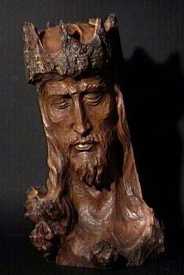Victim and Victor: Christ as the Archetype of Comedy
 Nelvin Vos argues that because Christ is the ultimate expression of God's truth, that his life, death, and resurrection are the underlying pattern behind human aspirations towards comedy. By suggesting this, he is assuming two things: 1) that "the comic spirit" of life transcends our notions of humor to include the shape of our narratives, i.e. a plot may be comic because it ends well or possesses a certain irony, even if it isn't gut-busting funny on the surface of things; 2) that Christ enacted in his earthly ministry the same pattern by which he shaped creation -- a pattern that humans, even without the specific knowledge of Christ, nonetheless discern. Thus, Vos contends that comic characters and plots tend to imitate either part or all of Christ's own pattern. "Comedies of wit" tend to offer worlds without any real pain or suffering, whose sense of purpose is self-assured. "Comedies of the ludicrous", on the other hand, focus on worlds which are bitterly ironic because they offer little sense of purpose; indeed, they mock the purposeless world. Vos ultimately suggests that the most "Christ-like " comedies are those that bring together victimhood (suffering, betrayal, etc.) with perception through testing. "The Holy Fool" is one who enters into the world's pain and suffering in all its irony but overturns it through a perception of truth and new purpose.
Nelvin Vos argues that because Christ is the ultimate expression of God's truth, that his life, death, and resurrection are the underlying pattern behind human aspirations towards comedy. By suggesting this, he is assuming two things: 1) that "the comic spirit" of life transcends our notions of humor to include the shape of our narratives, i.e. a plot may be comic because it ends well or possesses a certain irony, even if it isn't gut-busting funny on the surface of things; 2) that Christ enacted in his earthly ministry the same pattern by which he shaped creation -- a pattern that humans, even without the specific knowledge of Christ, nonetheless discern. Thus, Vos contends that comic characters and plots tend to imitate either part or all of Christ's own pattern. "Comedies of wit" tend to offer worlds without any real pain or suffering, whose sense of purpose is self-assured. "Comedies of the ludicrous", on the other hand, focus on worlds which are bitterly ironic because they offer little sense of purpose; indeed, they mock the purposeless world. Vos ultimately suggests that the most "Christ-like " comedies are those that bring together victimhood (suffering, betrayal, etc.) with perception through testing. "The Holy Fool" is one who enters into the world's pain and suffering in all its irony but overturns it through a perception of truth and new purpose.
Christ the Victor
Christ the Victim
Suffering Servant, Lowly and Unrecognized, Betrayed and Rejected, Sacrificial Lamb
Christ Victim and Victor
(Victor) "Comedy of Wit"
- Little or no suffering/ passion
- A perception of purpose in the world
- Triumphant and Victorious
(Victim) "Comedy of the Ludicrous"
- Little sense of purpose
- A perception of suffering and passion in the world
- Seems defeated or victimized
(Together) "Comedy of the Holy Fool"
- Convinced of purpose in the world
- Tested by suffering and passion
- Reaches a new perception through mortification and triumph
